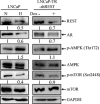REST reduction is essential for hypoxia-induced neuroendocrine differentiation of prostate cancer cells by activating autophagy signaling
- PMID: 27034167
- PMCID: PMC5041970
- DOI: 10.18632/oncotarget.8433
REST reduction is essential for hypoxia-induced neuroendocrine differentiation of prostate cancer cells by activating autophagy signaling
Abstract
Prostate cancer (PCa) with neuroendocrine differentiation (NED) is tightly associated with hormone refractory PCa (HRPC), an aggressive form of cancer that is nearly impossible to treat. Determining the mechanism of the development of NED may yield novel therapeutic strategies for HRPC. Here, we first demonstrate that repressor element-1 silencing transcription factor (REST), a transcriptional repressor of neuronal genes that has been implicated in androgen-deprivation and IL-6 induced NED, is essential for hypoxia-induced NED of PCa cells. Bioinformatics analysis of transcriptome profiles of REST knockdown during hypoxia treatment demonstrated that REST is a master regulator of hypoxia-induced genes. Gene set enrichment analysis (GSEA) of hypoxia and REST knockdown co-upregulated genes revealed their correlation with HRPC. Consistently, gene ontology (GO) analysis showed that REST reduction potential associated with hypoxia-induced tumorigenesis, NE development, and AMPK pathway activation. Emerging reports have revealed that AMPK activation is a potential mechanism for hypoxia-induced autophagy. In line with this, we demonstrate that REST knockdown alone is capable of activating AMPK and autophagy activation is essential for hypoxia-induced NED of PCa cells. Here, making using of in vitro cell-based assay for NED, we reveal a new role for the transcriptional repressor REST in hypoxia-induced NED and characterized a sequential molecular mechanism downstream of REST resulting in AMPK phosphorylation and autophagy activation, which may be a common signaling pathway leading to NED of PCa.
Keywords: REST; autophagy; hypoxia; neuroendocrine differentiation; prostate cancer.
Conflict of interest statement
The authors disclose no potential conflicts of interest.
Figures









References
-
- Aloysius H, Hu L. Targeted prodrug approaches for hormone refractory prostate cancer. Med Res Rev. 2015;35:554–585. - PubMed
-
- Conteduca V, Aieta M, Amadori D, De Giorgi U. Neuroendocrine differentiation in prostate cancer: current and emerging therapy strategies. Crit Rev Oncol Hematol. 2014;92:11–24. - PubMed
-
- Jin RJ, Wang Y, Masumori N, Ishii K, Tsukamoto T, Shappell SB, Hayward SW, Kasper S, Matusik RJ. NE-10 neuroendocrine cancer promotes the LNCaP xenograft growth in castrated mice. Cancer Res. 2004;64:5489–5495. - PubMed
-
- Burchardt T, Burchardt M, Chen MW, Cao Y, de la Taille A, Shabsigh A, Hayek O, Dorai T, Buttyan R. Transdifferentiation of prostate cancer cells to a neuroendocrine cell phenotype in vitro and in vivo. J Urol. 1999;162:1800–1805. - PubMed
MeSH terms
Substances
LinkOut - more resources
Full Text Sources
Other Literature Sources
Medical
Research Materials

